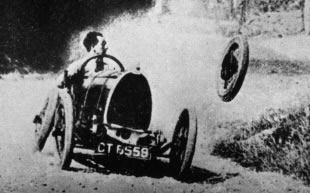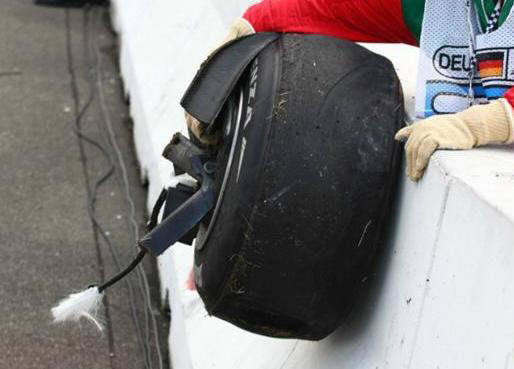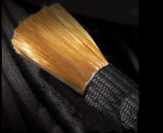Wheel tethers
 |
Raymond Mays loses a wheel on Brescia at Caerphilly hillclimb in the 1920s |
Since 1998, F1 cars have had to fit wheel tethers connecting the wheels to the chassis. This rule was introduced to try to stop wheels coming free and bouncing around dangerously during an accident. The tether must be attached to the chassis at one end, and with the other end connected to the wheel hub (wheel assembly). They are hidden in and passing trough the suspension arms. Unfortunately, we also see wheels coming off Formula 1 cars rather more often than we'd like. The tethers are working, but they're not reliable enough, tragically killing a marshall at the Italian GP in 2000 and we had the fatal Formula 2 accident at Brands Hatch last season that claimed the life of Henry Surtees after he was struck on the head by a loose wheel that had broken away from a car in front of him on track . But every time a tether has prevented a wheel from becoming detached and fly from the car, it has potentially prevented death or injury to the driver, marshal or other drivers. On the picture below, you can see wheel tether from period when only one tether was in use.

After discussion at the Technical Working Group, the FIA have introduced an extra tether to each wheel for the 2011 season to try to stop the wheels coming off and causing injury to other drivers, marshals or spectators. Rather than thinking that each tether is 100% reliable, new approach is that if you put two tethers on each corner that are run independently, so fully redundant – one in, say, the top wishbone and one in the bottom wishbone – then we're going to drastically improve the probability that one or both tethers will survive in an accident.
Le Mans Prototype LMP cars will get them from 2014 on.
The FIA approved wheel tethers are made by two companies (TECHNICAL LIST N° 37, List of cables in compliance with the "FIA standard for Formula One wheel restraint cables"), one in the UK, Future Fibres in London, and Cortex Hümbelin AG in Rupperswil, Switzerland been the other, and take the form of a rope. The tethers used in F1 are a derivative of high performance marine ropes, made especially for each car. They are made from a special polymer called polybenzoaoxide (PBO) which is often called Zylon. Zylon material has a very high strength and stiffness characteristic (around 2700 MPa), more than carbon, but the advantage of Zylon is that it can be used as a pure fibre unlike carbon which has to be in composite form to gain its strength.
 The drawback of Zylon is that he must be protected from light, so it is covered in a shrink wrapped protective cover. The tethers are designed to withstand about 5500 kg of load, but often they can break quite easily during an accident, especially if the cable gets twisted by the broken suspension members. The teams normally replace the tethers every two or three races to ensure that they can withstand the loads put on them during an accident.
The drawback of Zylon is that he must be protected from light, so it is covered in a shrink wrapped protective cover. The tethers are designed to withstand about 5500 kg of load, but often they can break quite easily during an accident, especially if the cable gets twisted by the broken suspension members. The teams normally replace the tethers every two or three races to ensure that they can withstand the loads put on them during an accident.
Double wheel tethers for 2011
For safety reason a doubling of the wheel tethers has been regulated for season 2011. Each tether needs to pass through a different suspension member and have its own mounting points on the upright and the chassis. There’s not expected to be any performance impact with this. But the tethers are somewhat heavier, so they and the side intrusion panel are part of the reason for the greater minimum weight limit.
The question of flying wheels still remains difficult because wheel tethers can only absorb so much of an impact without ripping out their mountings.
10.3.6 In order to help prevent a wheel becoming separated in the event of all suspension members connecting it to the car failing provision must be made to accommodate flexible tethers, each with a cross sectional area greater than 110mm². The sole purpose of the tethers is to prevent a wheel becoming separated from the car, they should perform no other function.
The tethers and their attachments must also be designed in order to help prevent a wheel making contact with the driver's head during an accident.
Each wheel must be fitted with two tethers each of which exceed the requirements of 3.1.1 of Test Procedure 03/07.
Each tether must have its own separate attachments at both ends which :
- Are able to withstand a tensile force of 70kN in any direction within a cone of 45°
(included angle) measured from the load line of the relevant suspension member.
- On the survival cell or gearbox are separated by at least 100mm measured between the centres of the two attachment points.
- On each wheel/upright assembly are separated by at least 90° radially with respect to the axis of the wheel and 100mm measured between the centres of the two attachment points.
- Are able to accommodate tether end fittings with a minimum inside diameter of 15mm. Furthermore, no suspension member may contain more than one tether.
Each tether must exceed 450mm in length and must utilise end fittings which result in a tether bend radius greater than 7.5mm.






